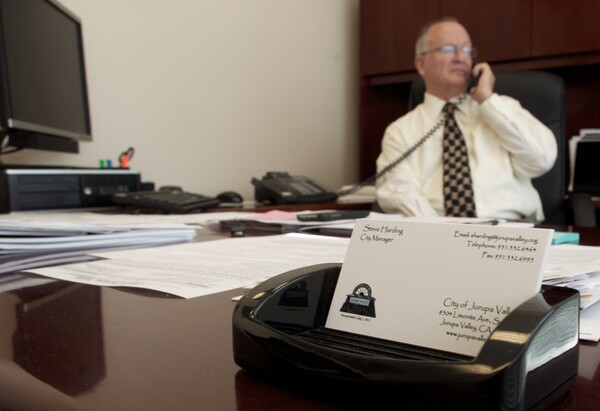Newest California City to Lobby For its Existence

A boulder put the city on the map. Sacramento may take it off.
When the LACMA rock was being prepared for its commute to the Miracle Mile, it gave a lot of attention to a quarry just north of Riverside. That is when some learned that the rock is from Jurupa Valley, a city that was founded just last year.
During summer 2011, last-minute state legislation was added to the budget bill and may force the new city to consider recalling cityhood before it even selects an official seal.
That is the something officials are afraid to say, but admit is true.
"It took five years to become a city," said Jurupa Valley Councilmember Frank Johnston, who also served as Vice-President of the incorporation committee. "Fiscal analysis -- as required by state law -- identified revenue sources and expenses. One source was motor vehicle fees that new cities receive in lieu of property tax."
As part of a 2004-05 State of California budget agreement, bill AB 1602 reallocated and switched revenue streams from Motor Vehicle In-Lieu Fees (MLFV) and property taxes. Cities incorporating after August of 2004 would not be able to access Property Tax monies under the "MVLF-Property Tax Swap." Instead, those new civic bodies would receive $50 per capita funding provided by vehicle fees, then reduced each year during its first five years.
With that, and other resources, the growing population of voters from the rural region, including old communities like Mira Loma, Pedley, and Rubidoux,approved a March 2011 ballot measure to incorporate.
Jurupa Valley's first day as a city was July 1, 2011. Laura Roughton, the city's first Mayor, was ready to lead staff and open a functional City Hall for business and services in a strip mall.
In comes another bill, SB 89, which was approved by Gov. Brown June 30, 2011, taking away MVLF funding from new California cities. With it, Jurupa Valley lost $6.7 million, up to 46% of its first-year operating budget overnight.
"We found out with a late-night phone call," recalled City Manager Steve Harding. "We were two days from opening the doors of City Hall."
The stealth SB 89 was walked on the floor in the late evening of June 28, 2011, with no committee reviewing the bill that trailed Senate (Budget) Bill 87, according to the League of California Cities. When signed by Gov. Brown, protest sparked once it was realized how the cash flow shift impacted new cities -- without the chance for the bill to be reviewed by the upstarts or finance committees.
Brown's office first excused it as a casualty of "Republican lawmakers' refusal to let California voters decide whether to support tax extensions to plug a $9.6 billion hole in Sacramento's budget," so reported the North County Times on June 30, 2011. "The Republicans blocked that vote" and asked for deep spending cuts instead, said Gil Duran, Brown's press secretary. "So don't demand cuts and then complain about cuts." The NC Times also reported that the governor "had no interest in discussing the matter with the local lawmakers" and quoted Duran as saying: "We're moving on. They should too." (No bill author or sponsor was found on online public record).
Since then, with support of a bipartisan committee of state senators and county supervisors, Brown's office has been walked through the impact of the bill, explained Harding. "After three meetings, it finally sunk in. They just did not understand what happened," he said. "We don't think it was draconian. Not enough research was done. It was seen as just a shift of money.
"They have to realize this money comes from DMV accounts that cannot be used for state activities," added the City Manager. "It has to come back to local government. We are only asking to reinstate what AB 1602 did: allocate funding to put us on an equal playing field with other cities -- which we are not."
Other new cities in Riverside County lost funding, estimated the League of California Cities: Eastvale is out $2.9 million, Menifee would lose $3.6 million, and Wildomar will be short $1.7 million.
Public safety is at risk for all cities, officials also warned. Jurupa Valley estimates the budget for Riverside County Sheriff's will be reduced by 20%. To stay afloat, the city was forced to obtain a loan from Riverside County (which has since been paid back).
The bipartisan campaign will return to Sacramento this week to lobby for the return of revenue through a new bill, SB 1566, first introduced in February. It would reverse the budget-killing SB 89, and reinstate most provisions provided by AB 1602 by July 1, 2012. The California State Senate Governance And Finance committee will hold a hearing April 18.
This Governor's push to shift funding had huge political implications, argued Harding. "Will this State, or any other State, be willing to see cities become insolvent by State action?"


